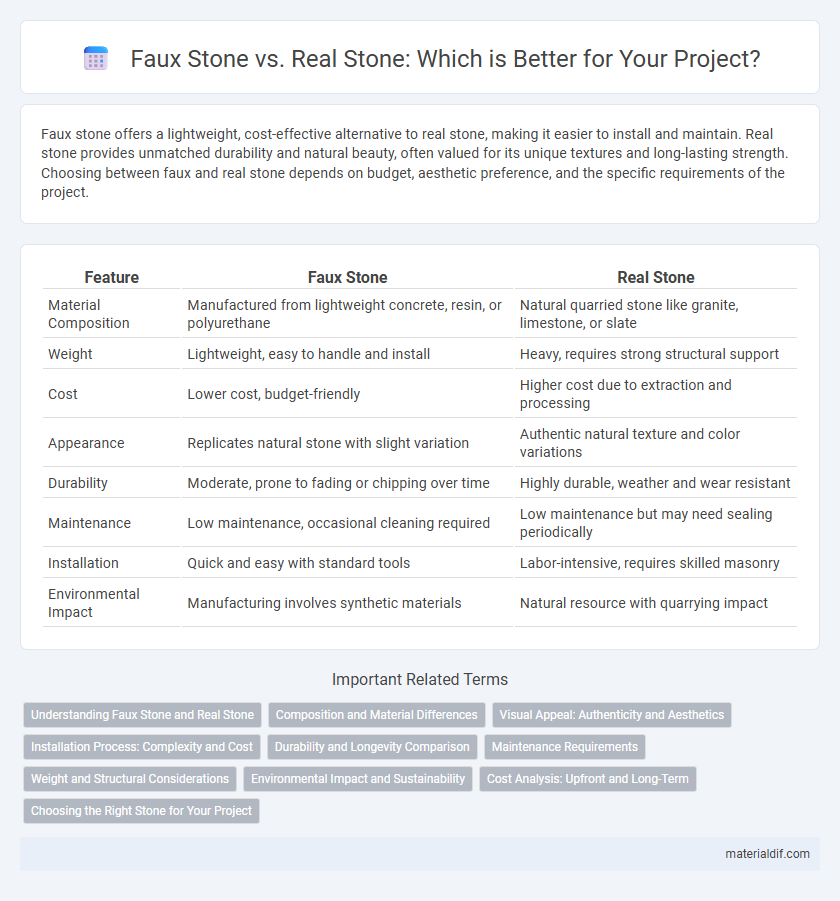Faux stone offers a lightweight, cost-effective alternative to real stone, making it easier to install and maintain. Real stone provides unmatched durability and natural beauty, often valued for its unique textures and long-lasting strength. Choosing between faux and real stone depends on budget, aesthetic preference, and the specific requirements of the project.
Table of Comparison
| Feature | Faux Stone | Real Stone |
|---|---|---|
| Material Composition | Manufactured from lightweight concrete, resin, or polyurethane | Natural quarried stone like granite, limestone, or slate |
| Weight | Lightweight, easy to handle and install | Heavy, requires strong structural support |
| Cost | Lower cost, budget-friendly | Higher cost due to extraction and processing |
| Appearance | Replicates natural stone with slight variation | Authentic natural texture and color variations |
| Durability | Moderate, prone to fading or chipping over time | Highly durable, weather and wear resistant |
| Maintenance | Low maintenance, occasional cleaning required | Low maintenance but may need sealing periodically |
| Installation | Quick and easy with standard tools | Labor-intensive, requires skilled masonry |
| Environmental Impact | Manufacturing involves synthetic materials | Natural resource with quarrying impact |
Understanding Faux Stone and Real Stone
Faux stone is a manufactured material designed to replicate the appearance and texture of real stone, offering a lightweight, cost-effective alternative with easier installation. Real stone, formed naturally through geological processes, provides unmatched durability, unique patterns, and authentic aesthetics valued in construction and design. Understanding the differences in composition, weight, maintenance requirements, and longevity helps homeowners and builders choose the best option for their specific application.
Composition and Material Differences
Faux stone is typically made from lightweight materials such as polyurethane, resin, or cement-based composites, designed to mimic the appearance of natural stone with ease of installation and reduced weight. Real stone consists of naturally occurring minerals like granite, limestone, or slate, offering superior durability, unique textures, and natural color variations formed over thousands of years. The inherent density and mineral composition of real stone provide greater longevity and weather resistance compared to the synthetic compounds used in faux stone products.
Visual Appeal: Authenticity and Aesthetics
Faux stone offers a consistent and customizable appearance, mimicking the texture and color variations of real stone with a lightweight design suitable for diverse applications. Real stone boasts unmatched authenticity and natural aging, creating a unique visual appeal through its complex patterns and organic imperfections. The choice between faux and real stone depends on the desired aesthetic impact and the need for genuine texture versus design flexibility.
Installation Process: Complexity and Cost
Faux stone offers a simplified installation process compared to real stone, as it is lighter, easier to cut, and can be applied directly to various surfaces, reducing labor time and overall cost. Real stone requires skilled masonry work, heavy lifting, and precise fitting, leading to higher labor expenses and longer project timelines. The complexity of real stone installation often results in increased material handling fees and specialized tools, making faux stone the more cost-effective and efficient choice for many construction projects.
Durability and Longevity Comparison
Real stone offers superior durability and longevity, often lasting for centuries due to its natural resistance to weathering, impact, and erosion. Faux stone, made from lightweight composite materials, may be more susceptible to chipping, fading, and cracking over time, especially in extreme climates. While faux stone provides a cost-effective and easier installation alternative, real stone remains the best option for long-term structural integrity and minimal maintenance.
Maintenance Requirements
Faux stone requires significantly less maintenance than real stone, as it is resistant to cracking, chipping, and weathering. Real stone demands periodic sealing, cleaning, and repair due to its natural porosity and susceptibility to erosion and moss growth. Choosing faux stone can reduce long-term upkeep costs and effort while maintaining a similar aesthetic appeal.
Weight and Structural Considerations
Faux stone is significantly lighter than real stone, reducing the load on structural supports and making it ideal for remodeling and facade applications where weight limits are a concern. Real stone's substantial weight requires reinforced foundations and framing, increasing construction costs and complexity. Choosing between faux and real stone depends on the project's structural capacity and desired aesthetic authenticity without compromising safety.
Environmental Impact and Sustainability
Real stone offers superior environmental sustainability by being a natural, durable material with minimal processing, which reduces energy consumption and waste. Faux stone, often made from synthetic resins or concrete, involves higher energy-intensive manufacturing and can contain non-biodegradable components, contributing to greater environmental impact. Choosing real stone supports long-term ecological balance through its recyclability, low carbon footprint, and natural degradation.
Cost Analysis: Upfront and Long-Term
Faux stone typically costs 50-80% less upfront compared to real stone, making it a budget-friendly option for projects with tight financial constraints. Real stone, while more expensive initially due to quarrying and labor-intensive installation, offers greater durability and can increase property value over time, potentially offsetting the higher costs. Long-term maintenance expenses for faux stone tend to be lower, but its lifespan is shorter than real stone, which can last decades with minimal upkeep.
Choosing the Right Stone for Your Project
Faux stone offers lightweight, cost-effective versatility ideal for interior walls and decorative accents, while real stone provides unmatched durability and natural beauty suited for exterior facades and heavy-traffic areas. Consider project requirements like budget, structural support, and desired aesthetic to determine the appropriate material. Selecting the right stone involves balancing longevity, maintenance, and environmental impact to ensure a successful and sustainable installation.
Faux Stone vs Real Stone Infographic

 materialdif.com
materialdif.com